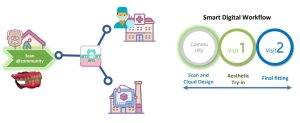Introducing SmartRPD, a technology by the National Dental Centre Singapore (NDCS) which combines digital workflows and 3D printing to improve the accuracy and efficiency of removable partial dentures (RPDs) production.
As Singapore’s population continues to age, the demand for accessible and efficient oral healthcare solutions grows. Tooth loss, or edentulism, is a pressing issue among seniors above 65 years of age. About two-thirds of seniors have severe tooth loss and 3% of seniors have no teeth. On average, only 11 teeth remain among seniors in the community. These seniors will need to rely on dentures to maintain basic functions like eating and speaking.
In 2020, Singapore’s annual demand for RPDs reached 40,000, and this number will grow as projections show 24% of the population will be 65 or older by 2030. Furthermore, RPDs do not last forever, and typical require replacement every 5-10 years for best function.
Zobrazit příspěvek na Instagramu
Addressing these challenges head-on, the National Dental Centre Singapore (NDCS) has introduced SmartRPD, a technology leveraging digital workflows and 3D printing to improve the production of removable partial dentures (RPD).
This innovation will revolutionise oral healthcare for seniors by enhancing their quality of life and meeting the rising demand for dental prosthetics.
Addressing Challenges in Conventional RPD Fabrication
The conventional fabrication of RPDs has long been riddled with inefficiencies. This labour-intensive process often results in fitting issues affecting 20-30% of patients, leading to discomfort, multiple clinic visits, and extended treatment timelines.

By replacing manual methods with a digital workflow that integrates intra-oral scanning, automated design, and 3D printing, SmartRPD is able to bypass these challenges.
This transformation cuts the error rate to about 3%. Patients benefit from fewer visits (down from five to three) while clinicians experience greater productivity and satisfaction.
According to NDCS, SmartRPD not only improves treatment outcomes but also makes the process more sustainable.
By streamlining workflows and automating manufacturing, the technology allows clinicians to serve more patients, and at the same time deliver higher-quality dentures that last longer.
Impact on Elderly Oral Healthcare
Edentulism—tooth loss—is a prevalent issue among seniors in Singapore, with a 2017 survey showing that 69% of those aged 65 and above wear dentures.
Tooth loss among seniors isn’t just a dental issue. Poor oral health can lead to malnutrition, increasing the risk of chronic diseases like diabetes and cardiovascular conditions. Dentures play a critical role in mitigating these risks by restoring essential functions.
SmartRPD offers a solution by improving the fit and functionality of dentures. This significantly enhancing the quality of life for elderly patients.
“If this [SmartRPD] workflow is widely adopted, it is expected to increase efficiency, allowing dentists to see more patients.” Dr Yu Na shared. She is the lead principal investigator from NDCS in the pilot clinical trial of the SmartRPD workflow.
The streamlined process allows clinicians to dedicate more time to addressing complex cases and educating patients, creating a more holistic approach to dental care.
Integration into Clinical Settings
The adoption of new technology in healthcare often comes with challenges, but NDCS is taking a phased approach to ensure the seamless integration of SmartRPD.
“The focus is on demonstrating its cost-effectiveness and ease of use in real-world settings.” explained Dr Yu Na.
This involves collaborating with general dentists and specialists through pilot programmes and tailored training sessions. Refinements are made to ensure that the technology meets the unique needs of various clinical environments, both in public and private settings.
Additionally, through the cost-effective nature of SmartRPD, NDCS aims to encourage widespread adoption across Singapore’s dental care ecosystem. Through its ability to save time and resources while delivering superior outcomes, this innovation has the potential to improve Singapore’s approach to dental care.
Looking Ahead: The Future of SmartRPD
“The future of SmartRPD lies in enhancing accessibility and usability.”
The development of SmartRPD doesn’t stop here. NDCS has ambitious plans to enhance the technology further.
One key goal is to integrate SmartRPD seamlessly with clinic systems, potentially offering it as a cloud-based platform. This would make it more accessible to dental practices of all sizes.
Another is to ensure that all clinicians can quickly adopt the technology, with minimal training. Dr Yu Na shared that the team prioritises usability improvements to ensure minimal barrier t adoption.
Additionally, SmartRPD aims to expand support for both public and private dental clinics. With a wide network of adoption across Singapore, more patients can benefit from this innovation in Singapore’s dental care ecosystem.
As Singapore braces for increased dental care demand, SmartRPD highlight the importance of combining technology with patient-centric approaches. With its potential to both transform clinical workflows and enhance patient outcomes, SmartRPD represents a great leap forward in elderly oral healthcare.
The team will begin phase two of the clinical trial later in the year with 300 patients from 40 clinics.
The research is funded by the Ministry of Health (MOH) through the National Medical Research Council (NMRC) office, MOH Holdings as well as by Temasek and Temasek Foundation.

